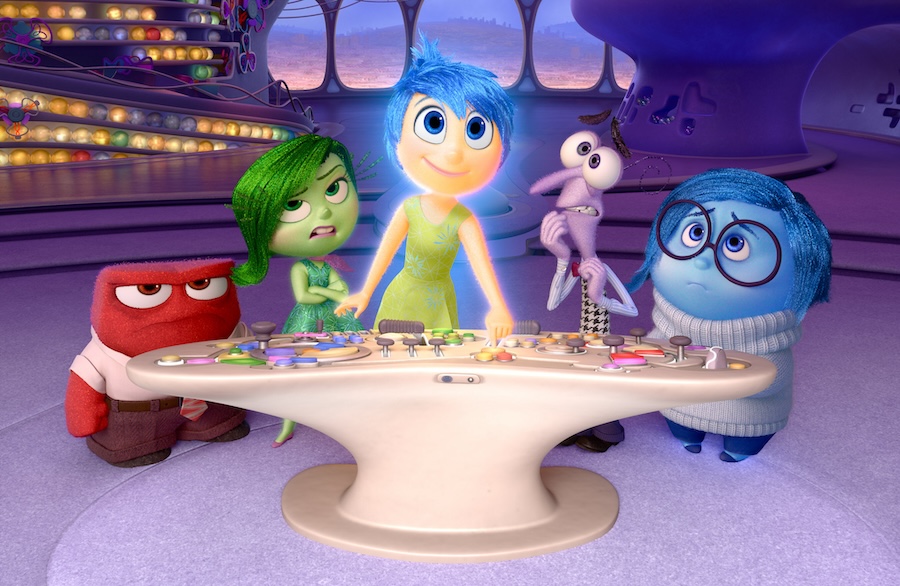
MEET THE LITTLE VOICES INSIDE YOUR HEAD.

In 2009, director Pete Docter had completed and released the phenomenal Pixar film Up when he started noticing things about his preteen daughter Elie. She was becoming more shy and reserved, going through a process that Docter recognized from his own childhood. As he looked into the science behind what it is in our minds that form a personality, the idea for a new movie started taking shape. It was a gamble for Pixar, becoming the first project that lacked input from two of the company’s key figures, Steve Jobs (who passed away in 2011) and John Lasseter (who was busy elsewhere). There was also concern over how to market a film like this, Pixar’s thematically most ambitious.
Moving to San Francisco
When Riley is born one day in Minnesota, she enters life with a set-up of emotions – Joy, Sadness, Fear, Disgust and Anger, who are all manifestations in her mind, or Headquarters as it is known to this motley bunch. They all influence Riley in different ways, using a control console. When the girl is 11, she and her parents move to San Francisco, and things begin to happen. Joy and the other emotions have never quite understood the purpose of Sadness, but suddenly she’s becoming more active in ways that look accidental.
When Sadness causes Riley to cry in front of her class as she’s describing a memory from Minnesota, Joy is horrified to see this core memory turn “blue”. Riley’s memories consist of little orbs that carry the specific colors of each memory’s dominant emotion. Before this new sad memory orb reaches the central hub where it is stored, Joy tries to get rid of it… but then disaster strikes.
Consulting psychologists
It’s not the easiest story to recap, especially when you consider that this is a movie meant to be understood and appreciated by children. Hopefully they’ll enjoy the surface (colorful characters, the 3D action, the comedy) and maybe even grasp part of the message, which is it’s OK to feel sad sometimes. Adults will relate to this movie in more ways, as it will remind them of their own childhood, make them think about how their own kids are developing and understand some of the science behind it. Docter and his collaborators spent a lot of time crafting the concept and consulted psychologists, including Paul Ekman who has written about our core emotions in the past. Turning them into characters in the movie is a smart and fun idea, even if there are moments when the boisterous comedy of each emotion, except Sadness, becomes a tad strained or overly noisy. Still, the filmmakers found the perfect cast to bring their personalities to life.
The most memorable character however is Bing Bong, Riley’s imaginary friend (who’s part elephant, part cotton candy, among other things), an absurd figure who becomes of invaluable help to Joy later in the film; Richard Kind is hilarious and heartbreaking in that role.
The film’s depth of emotion is reinforced by Michael Giacchino, who has once again written a beautiful theme.
It’s interesting to see how Docter’s films are connected, from how a child’s fear was explored in Monsters, Inc. (2001) to kids bonding with older generations in Up. As in those movies, there’s also always a fun, creative adventure, be it in a city of monsters, or South America, or deep inside the mind of a little girl. The film’s depth of emotion is reinforced by Michael Giacchino, who has once again written a beautiful theme, cleverly variated throughout.
The last truly great Pixar film was Toy Story 3 (2010), and the studio seems to have gotten sequels on its brain just like the rest of Hollywood. Which is why it’s a relief to see an original project like Inside Out work out so well. It is a true Joy to watch.
Inside Out 2015-U.S. Animated. 94 min. Color. Produced by Jonas Rivera. Directed by Pete Docter. Screenplay: Pete Docter, Meg LeFauve, Josh Cooley. Music: Michael Giacchino. Voices of Amy Poehler (Joy), Phyllis Smith (Sadness), Richard Kind (Bing Bong), Bill Hader, Lewis Black, Mindy Kaling, Diane Lane, Kyle MacLachlan… Frank Oz, John Ratzenberger, Flea, Rashida Jones.
Trivia: Poehler and Hader are credited for having written additional dialogue. Followed by Inside Out 2 (2024).
Oscar: Best Animated Feature. Golden Globe: Best Animated Feature. BAFTA: Best Animated Film.
Last word: “If you remember from when you were, you know, in second grade and there was Christmas and you got a present from your grandfather and your mom was wearing a red dress, that may or may not all have happened. It might have been introduced slowly over the course of the years as you recall this memory over and over. So that was a very cool but complex idea that we thought about representing in the film but could not find a way to make it work. We actually needed the memory […] as a very different kind of a plot device of revealing some information to our main character. So we chose to represent it as these sort of beautiful little snow globes, which kind of, weirdly, that’s the way we think of memories. You think of these memories as being very pure and absolute and unchanging. That’s not actually real life.” (Docter, NPR)
